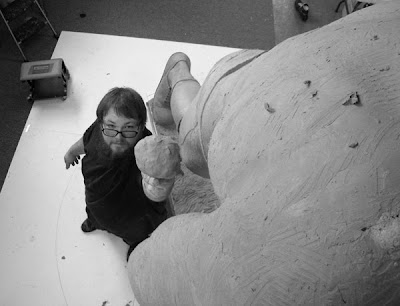We’re deep in the midst of the John David Crowe Monument project. The finished piece will measure almost 12 feet in height and the shear size of the project brings with it a host of challenges. First we’ve had to relocate large elements of the studio to an off-site annex studio with larger ceilings to permit Steven to work on the complete figure. The soaring figure is like a two story building and Steven spends much of his time either up on a ladder or on the new scaffolding we bought for the project. It’s caused a funny dynamic in the studio that reminds me of the power of having the top bunk when I was younger. Once up on the scaffolding, it’s hard to get down and the studio staff is forced to scramble around handing Steven everything from warm clay to glasses of water.

The actual construction of the piece is a mixture of old and new techniques. Steven studied in England and was trained in a very traditional and classical manner. We continue to find our greatest inspiration in the artistic achievements of the past ranging from the Albert Memorial to the Statue of Liberty. These mammoth memorials were produced in pain-stacking protracted techniques. In part it is this struggle that makes the finished monuments so truly awesome. Our monument work is an effort to successfully replicate the spirit of these historic landmarks while taking advantage of the benefits of modern technology.

Today many large-scale works are created with the use of computers in a process called foam enlargement. A sculptor creates a small version of a sculpture and then a computer scans the piece, calculates the rate of enlargement and then programs a laser to cut the larger version piece out of a block of very dense foam. This foam sculpture is then used in place of a traditional clay sculpture to produce the final bronze version of the piece. The process saves huge amounts of time and labor and eliminates many of the risks associated with a project of this size. But for us, the technique takes away from the overall impact of the piece and the distance it creates between the finished sculpture and the artist negatively impacts the artist process and the final creation.

As a result as we move forward with the project, we are constantly balancing the physical implications of the massive volume with our ultimate commitment to creating a product of high artistic quality. All of Steven’s sculptures are created with an armature or base that gives shape and support to the piece. Normally we use the armature to give the general suggestion of the figure, but in order to keep the Crow piece light enough to be even partially mobile Steven has added to the basic metal armature and sculpted the figure out of a new “sculptable” foam. He then lays thin sheets of clay over the foam body before addressing questions of texture and detailed expression.

As with so much of what we do the practicality of the process leads to elements of the surreal. Honored to be involved with such an impressive project, the whole staff remains frustrated with a week filled with rolling out dough/clay and working as a kind of temporary sculpture bakery. With apologies…I guess the project is starting to cook.


No comments:
Post a Comment